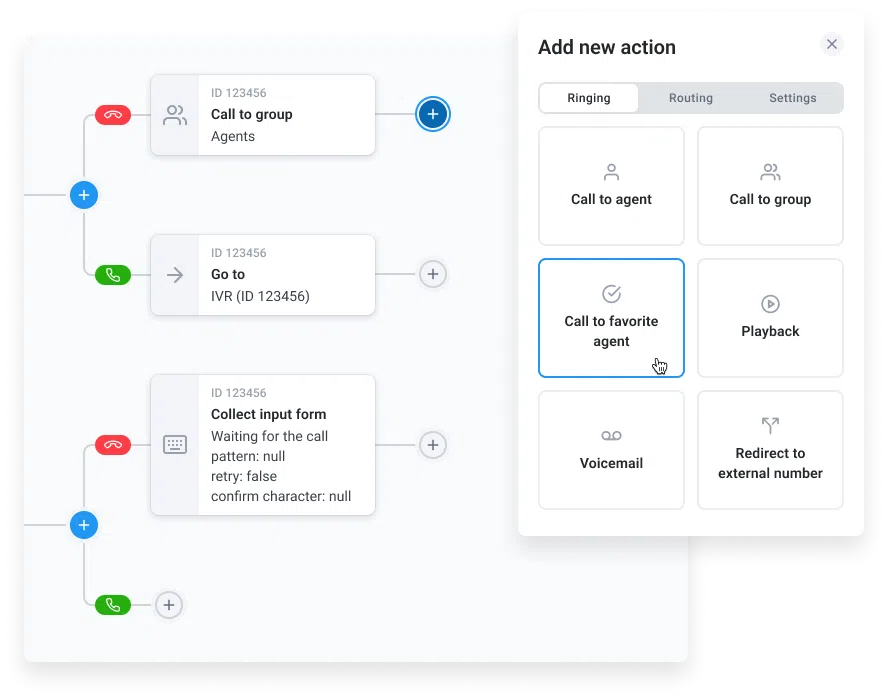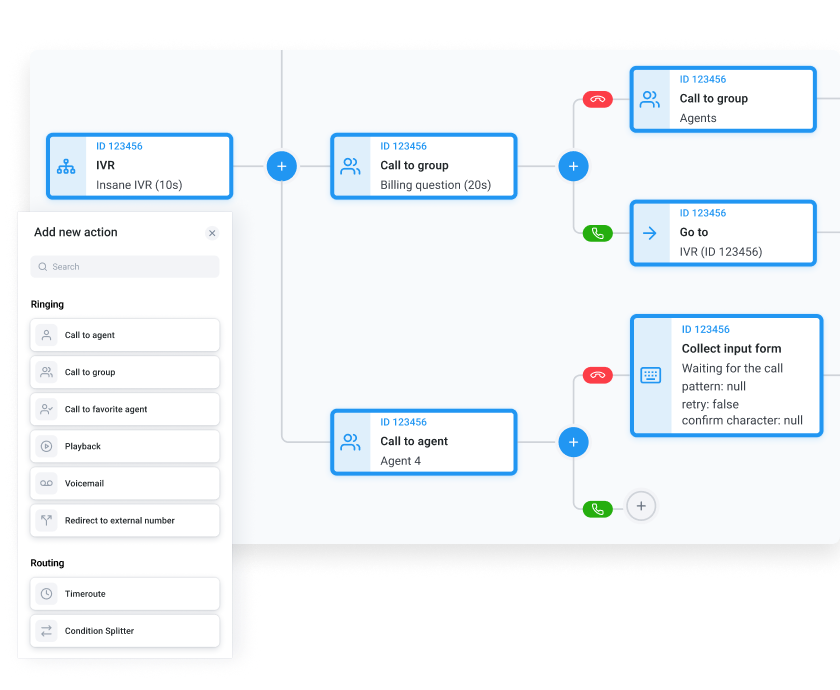
A customer calls their insurance provider to update a billing detail. The IVR menu lists six options—but none mention billing.
They guess “account services,” get routed to a claims agent, and have to start over. After explaining their issue twice and sitting through two holds, they’re frustrated enough to hang up or ask for a manager.
It’s a scenario every business wants to avoid. Yet, without an effective IVR call routing strategy, misrouted calls, long wait times, and unnecessary transfers can become everyday frustrations for both customers and your team.
You can proactively address this problem with IVR call routing, which uses customer history and intent to direct them to the right agent—so issues get resolved in minutes, not hours.
In this article, we’ll break down eight IVR routing strategies to help you streamline call handling and give customers the best possible experience.
Key takeaways:
- Optimized IVR call routing reduces average handle time (AHT) and improves first-call resolution (FCR).
- The right routing strategy bridges the gap between customer needs and agent specializations, ensuring faster resolutions and fewer transfers
- CloudTalk’s hosted IVR makes it easy to implement, test, and refine advanced routing strategies.
Resolve customer issues faster
What Is IVR Call Routing And Why It Matters
IVR call routing is more than just call directing. It’s a strategic approach to improve operational efficiency and the customer experience. Unlike legacy phone systems, a well-designed IVR ensures:
- Faster resolutions by directing customers to the right agent instantly.
- Fewer call transfers, reducing frustration and boosting CSAT scores.
- Personalized experiences using CRM data to anticipate caller needs.
An optimized IVR system leads to improved agent productivity and better queue management, making it indispensable for businesses of all sizes.
How a Hosted Contact Center Works
A hosted IVR operates within a cloud-based contact center, offering flexible, scalable, and remote-friendly call management. Unlike on-premise setups, a hosted contact center:
- Runs on cloud infrastructure, reducing hardware costs.
- Configures IVR routing rules by mapping out call paths based on factors like caller input, agent availability, and customer data right in the call flow designer.
- Allows remote teams to manage call routing from anywhere.
CloudTalk’s Call Flow Diagram feature makes it easy to build custom routing logic that adapts to your business’s needs, whether routing based on customer intent, past interactions, or priority status.
Build the perfect customer journey in just a few clicks with the CloudTalk Call Flow Designer.
Key Benefits Of Effective IVR Routing
Meet Janet, a Sales Operations Manager at an e-commerce company. Before implementing smart IVR routing, her team struggled with a backlog of misrouted calls and frustrated customers. Each misrouted call added an average of 3 minutes to handle times, and her CSAT scores reflected the problem.
If you’ve ever been in Janet’s position, you know how frustrating that can be. Strategic IVR routing can help you leave those scenarios behind. Key benefits include:
- Reduced average handle time (AHT): Smart routing ensures customers reach the right agent faster, reducing unnecessary hold times.
- Higher first-call resolution (FCR): Connecting customers with the right support from the start minimizes repeat calls.
- Fewer internal transfers: Intelligent routing reduces agent-to-agent transfers, improving operational efficiency.
- Priority handling for VIPs: High-value customers get routed to dedicated teams instantly.
- Better staffing & queue management: AI-driven routing balances workloads, preventing bottlenecks.
- Improved CSAT scores: Faster, more efficient resolutions lead to happier customers.
Integrating IVR in banking, retail, healthcare, and other industries can significantly improve both customer experience and the cost-efficiency of your internal operations. Just like Janet’s team, you can cut down handle times, reduce misroutes, and turn frustrated callers into satisfied customers—without adding headcount or complexity.
8 IVR Routing Strategies For Better Call Handling & Customer Experience
Before implementing smart routing, Janet’s team faced constant misroutes and long handle times. Now, her IVR system gets customers to the right place—fast.
With data-driven routing, automation, and real-time decisions, IVR can become a powerful tool for seamless, personalized service. Below are eight strategies to help you get there.
IVR Routing Strategy 1: Implement Skills-Based Routing

Transform your customer journey with an intuitive Call Flow Designer.
A user interface for the call flow designer showing a partial workflow diagram on the left and a menu with several options on the right.
Customers expect to speak to the right expert immediately. Skills-based routing matches callers with agents who have the expertise needed to resolve their issues. This strategy eliminates the frustration of being passed between departments and dramatically improves first-call resolution rates.
With a skills-based routing strategy, your IVR evaluates customer responses to menu options and cross-references them with available agent data. Then, it directs the caller to the most qualified agent for their specific needs.
How do you set it up? The exact process may vary depending on the tools you use, but CloudTalk makes it straightforward and fast. Here’s what you’ll need to do:
- Map your team’s skills and expertise levels in the CloudTalk dashboard.
- Create skill categories aligned with common customer inquiries.
- Use the Call Flow Designer to set up decision points based on customer input.
- Assign skill weightings to prioritize certain capabilities for specific issues.
Pro tip
Don’t just map technical skills. Consider language proficiency, industry knowledge, and soft skills like active listening and the ability to manage difficult conversations.
IVR Routing Strategy 2: Set Up Time-Based Routing
Customers don’t care about your business hours. They just want help when they call. If no routing rules are in place, after-hours calls may go unanswered, leading to missed opportunities and unhappy customers.
Time-based routing directs calls differently depending on the time of day, ensuring optimal coverage even during non-business hours or across global time zones.
How to implement it with CloudTalk:
- Define your business hours and after-hours protocols in the Call Flow Designer.
- Create separate routing paths for business hours versus after-hours.
- Set up time zone-specific routing for global teams.
- Configure holiday and special event routing in advance.
IVR Routing Strategy 3: Use Location-Based Routing
If your business operates across multiple locations, routing all calls to a central line can cause delays. Location-based routing directs callers to agents or departments based on the caller’s geographic location, ensuring they connect with someone familiar with their regional needs.
For global businesses, location-based routing can significantly reduce call times by avoiding cultural misunderstandings and addressing region-specific issues directly.
How to set it up:
- Configure CloudTalk’s IVR system to route calls based on the caller’s country, region, or area code.
- Use geolocation-based rules to direct calls to the nearest branch or regional office.
- Combine with language-based IVR menus to ensure customers receive support in their preferred language.
IVR Routing Strategy 4: Connect CRM Data To Your Routing Rules
Customers hate repeating themselves. Without CRM integration, callers may have to explain their issues multiple times, leading to frustration and longer call durations.
Data-driven routing uses historical customer data from your CRM to make intelligent routing decisions, creating a highly personalized experience.
How to implement it using CloudTalk:
- Integrate your CRM system with CloudTalk using our pre-built connectors.
- Define key customer data points that should influence routing, such as purchase history, support history, and account value.
- Create routing rules based on customer segments or past interactions.
- Set up routing to the same agent who handled previous interactions whenever possible.
IVR Routing Strategy 5: Prioritize VIP Callers Automatically
High-value customers expect premium service. Making them wait in a general queue risks losing revenue and damaging loyalty.
VIP routing ensures your most valuable customers receive priority service, improving retention of high-value accounts and recognizing customer loyalty.
To implement it, you’ll need to:
- Define VIP criteria such as spend threshold, account age, or contract value.
- Use CloudTalk’s Call Flow Designer to detect VIP numbers.
- Automatically route priority customers to a dedicated VIP support team.
- Set up immediate callback options if no suitable agent is available.
IVR Routing Strategy 6: Route Calls Based On Customer Intent (Payments, Sales, Support)
Not all callers have the same needs. Some may look for sales, while others need urgent technical support. Routing them incorrectly wastes both customer and agent time.
Intent-based routing directs callers based on the specific reason for their call, ensuring they reach the department best equipped to handle their needs without unnecessary transfers.
To implement this strategy:
- Set up AI-powered IVR testing to identify call intent based on voice input or keypad selections.
- Create clear, concise IVR menu options based on common customer intents. Simple examples include pressing “1” for sales, “2” for billing, and so on.
- Use voice recognition to identify keywords in customer responses.
- Route calls directly to specialized teams based on customer selections.
- Implement self-service options for routine inquiries and IVR payments.
DID YOU KNOW?
🤔Did you know?
A 2022 Gartner study found that 38% of millennial and Gen Z customers will abandon customer service interactions if they can’t resolve issues via self-service automation, highlighting the importance of efficient IVR.
IVR Routing Strategy 7: Build Dynamic Fallback Rules For When Agents Aren’t Available
What happens if no agent is available? Missed calls due to a lack of fallback rules will result in lost opportunities and dissatisfied customers.
Fallback routing ensures that callers always have a path to resolution, even when their ideal agent isn’t available, preventing abandoned calls and customer frustration.
To implement it:
- Define maximum wait time thresholds in your Call Flow Diagram.
- Create cascading priority rules for when primary queues exceed capacity.
- Set up voicemail options with guaranteed callback times.
- Implement queue position announcements to manage expectations.
IVR Routing Strategy 8: Use Post-Call Data To Continuously Improve Routing
To improve your IVR performance, you need to analyze it first. Data-driven optimization uses analytics from completed calls to refine your routing strategy, ensuring your system becomes more effective with each interaction. Plus, it reduces customer effort and improves CSAT scores over time.
To use this strategy with CloudTalk:
- Analyze transfer rates to identify routing issues.
- Review call recordings from transferred calls to understand what went wrong.
- Examine IVR testing results to identify abandoned paths.
- Schedulemonthly reviews of routing performance metrics.
Real-World Example: How DiscoverCars Improved Performance With IVR Routing

Create the perfect customer journey with CloudTalk’s IVR features.
A screenshot of a call flow configuration interface showing a visual workflow diagram.
DiscoverCars, a global car rental comparison service operating in 145 countries, was struggling to maintain a personalized service because of their fast-growing call volume.
The problem: With customers calling from around the world in multiple languages and time zones, DiscoverCars’ basic routing system couldn’t effectively match callers with appropriately skilled agents.
The solution: Using CloudTalk’s IVR routing capabilities, DiscoverCars implemented location-based routing combined with language detection to direct callers to agents fluent in their language automatically.
The results: Call abandonment rates dropped by 23%, first-call resolution improved by 37%, and customer satisfaction scores increased by 18 points.
This transformation improved operations and created a more seamless customer experience, proving the power of intelligent IVR routing in high-volume, multilingual environments. Read the entire story.
Optimizing IVR Call Routing For The Best Customer Experience
Instead of getting lost in endless menus and reaching the wrong agent, a well-optimized IVR gets the customer where they need to go. Strategies like skill-based routing or routing by call history connect them with the right expert fast. That means fewer follow-ups—and problems solved on the first try.
That’s exactly what Janet’s team did. By implementing skill-based and time-of-day routing, they eliminated misrouted calls, cut handle times, and boosted CSAT. The right strategy made the difference—what could it do for your team?
Achieving the best possible customer experience and business outcomes will depend on how well you align routing strategies with your key objectives.
Start by identifying your biggest pain points:
- High transfer rates? Implement skills-based routing.
- Global customer base? Focus on time and location-based routing.
- VIP retention issues? Prioritize data-driven and VIP routing.
Even small businesses can implement these strategies effectively with the right IVR system in place. CloudTalk’s scalable solutions work for teams of all sizes, from startups to enterprises.
The best results come from combining multiple strategies tailored to your customer journey—and optimizing them continuously based on real performance data.
Resolve customer issues faster
















